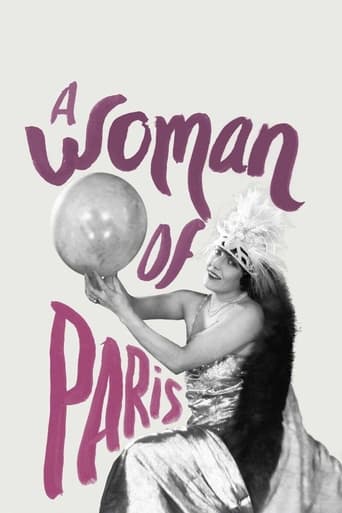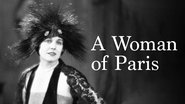Armand
one of films who surprises. again and again. for powerful , modern message, for the high acting - especially Lydia Knott -, for each scene who remains dramatic and impressive always. sure, it is not a surprise - Chaplin is a genius and that reality is out of comments. but it is not just a technical explanation for the force of film. the basic spice is measure. and the science of detail. the courage and the best cast. the use of universal types and characters of each society/period. the music and brilliant use of theater skills. result - not only a good movie but flavor of a special show. because all is created with high care. because it is not an old movie about lost events but a kind of mirror for each generation.
tarmcgator
"A Woman of Paris" is hardly the innovative work of genius that some Chaplin enthusiasts would have you believe, nor was it a flop just because moviegoers were disappointed that The Little Tramp was not to be seen in it. It's just a mediocre film, proof that genius can have an off day, or an off year, especially when it tries to push the envelope too much.I'm not sure who originated the truism that every comic yearns to play Hamlet, but certainly Chaplin aspired to make films that were more than gag-laden comedies. He had already tugged at the world's heartstrings with "The Kid" (1921), and within a couple of years he was ready to make a "serious" film that would entirely omit the comedy image that had made him the most famous movie star on the planet. He also wanted to feature his longtime co-star (and part-time inamorata), the lovely Edna Purviance, who had been a pleasant presence in about three dozen earlier Chaplin shorts and features. Apparently, he had great belief in her abilities as a dramatic actress.Unfortunately, Chaplin the writer/director didn't give his favored lady much to work with. The real weakness of "Woman" is the bland story, which has some rather large holes. Why do the fathers of Marie and Jean both object to their child's choice of fiancé(e)? How does a provincial girl like Marie -- who doesn't seem to have much going for her beyond her looks (Edna, who was 28 when "Woman" was released, looks harder and does not seem quite so fetching as she did five or six years earlier) -- develop in one year the ambition and cunning to become the mistress of "the richest bachelor in Paris?" How does she find out that Jean has moved to the city? None of these important plot points are really covered in the film. Chaplin seems to have thought that dazzling and risqué glimpses of the Parisian high life would be sufficient to hold the narrative together.Of course, Jean finds out that Marie is a prominent courtesan, and he's torn between his lingering love for her and his widowed mother's insistence on marital respectability. (Shades of "Camille!") After the tragic climax, we get a quick inter-title telling us that Marie has learned her lesson, and the film ends with her departure from the the Big City of Lights as the richest bachelor motors on his merry way.Kevin Brownlow and David Gill's explorations of Chaplin's creative process, "The Unknown Chaplin," makes it clear that Charlie didn't always have a firm grasp on the details of the story he was trying to tell -- and one suspects that may be why "Woman's" storyline is so pedestrian. Without the screen persona of the Tramp to guide him, and in his effort to make a "serious" dramatic film, Chaplin's inventiveness failed him in telling a compelling and believable story in which he did not appear.This was Purviance's last featured role in a Chaplin film. A few years later she starred in a Chaplin-produced movie, "A Woman of the Sea" (aka "The Sea Gull"), directed by Josef von Sternberg. (This film is now apparently lost; Chaplin reportedly refused to release it and ordered the negative destroyed for financial reasons.) It would have been nice to observe Edna working with another director, if only to see if she indeed did have the acting chops in which Chaplin believed. She made only one more film (not counting a couple of very small roles in two later Chaplin movies) before retiring in the late '20s. (Chaplin kept her on his payroll, however, until she died in 1958.)So, "A Woman of Paris" is essentially a Chaplin oddity, a film that every Chaplin fan ought to see at least once, if only to appreciate what the man accomplished in his comic films. But if Chaplin's name weren't on it -- contrary to some opinions -- it would remain a mediocre and unremarkable film, save for the appearance of Edna Purviance and the striking performance of Adolph Menjou.
JohnHowardReid
A Woman of Paris has all the makings of a film noir, but fails to deliver on this score, despite the tragic end met by one of the major characters. Chaplin, as writer/director/producer observes the action of this character at a distance (and the fact that he is enacted by a rather charmless Carl Miller further adds to an audience's lack of empathy).Despite Chaplin's Foreword insistence that his movie is not a comedy but a drama, it is actually for the most part an enjoyable comedy of manners, a field in which delightfully dapper Adolphe Menjou excelled, enabling him to easily snatch the picture from its nominal star, Edna Purviance. It seems Chaplin's camera cannot help but focus on Menjou. Chaplin's classy dialogue sub-titles also added a fillip, but Menjou's breezy, rich-as-they-come, luxuriantly self-indulgent take-it-it-leave-it manner would have ensured his success even without Chaplin's help.Chaplin actually conceived the film to launch Edna Purviance (who had starred with him in shorts like the 1919 Sunnyside) as a major star. This ploy was not successful. In my opinion, Miss Purviance lacked both the figure and the charisma that Hollywood stardom demanded. In the Chaplin shorts, she is little more than a foil for the tramp. In A Woman of Paris even newcomer Betty Morrissey and minor players like Malvina Polo, Henry Bergmam and Nelly Bly Baker steal scenes from her, to say nothing of Lydia Knott who compels attention as Jean's fussed mother.
Michael DeZubiria
A Woman of Paris is probably best known, ironically, by the fact that it is a Chaplin film that Chaplin does not appear in. It opens with a title card in which Chaplin himself wishes to clear up any misunderstanding by mentioning that he does not appear in the film, but my understanding is that it was a popular and critical failure at the time of its release. He does appear in the film, but walks on and off screen so fast and looks so little like himself that there is really no reason for him to be there. The film's popular failure seems to have been something that plagued him through the rest of his career, since he returned to the film and re-scored it at the age of 87. It was the last work he ever did as a filmmaker, and the result was that people finally recognized the film for the master work that it is. We meet a young woman whose father keeps her in the house under lock and key, but who nevertheless escapes at night to visit her lover, whom she plans to marry. One night, her father sees her leaving, and then locks her out. He then proceeds over-react to the point where he won't allow her in the house, so she is forced to try to go find a place to stay at her boyfriend's house. It is a curious illustration of 1920s society that his parents want to kick her out of the house as though she were a diseased rodent. They are committing an unpardonable sin by being together at night outside of marriage. It's easy to sympathize with their desperate situation.Soon, tragedy strikes, which leads to a tragic misunderstanding which, I have to say, is not presented very well in the movie. This is, however, probably the film's only weak point. I had to wonder why this even allowed for a level of misunderstanding that enabled her to move to Paris and join high society without ever talking to the man for long enough for him to explain what happened. It's also a little strange that they both appear to be in their mid-30s or so and are yet not only unmarried but still live with their parents. Nevertheless, she joins a wealthy social circle and becomes involved in their wealthy and loveless life, surrounded by rich people in constant leisure, smoking cigars, drinking champagne, and eating truffles ("a delicacy for pigs and gentlemen…"). It is inevitable that they will meet again at some point, and when they do, time has, indeed, made strangers of them, but his love is still alive. He has become an accomplished artist and she hires him to paint her portrait, which again intertwines their lives.It is interesting that he is still mourning the death of his father, even years later. But he comes from a world where relationships are extremely important, whether romantic or family, and she, on the other hand, has entered a world of money where relationships are startlingly meaningless. She drags her feet at talking about the history between them, saying that she doesn't want to dig up the past, while he interestingly looks directly at the camera and explains that he is still badly hurt by what has happened.Soon, she is forced to choose between a life of love or a life of luxury, and it is notable that the rich man that she was in a "relationship" is pointedly indifferent when she leaves him, explaining that he'll never see her again. "Okay, phone me sometime," he says as he casually walks out the door, leaving her to do as she will. Soon, things seem to be looking up for their mutual happiness, but another tragic misunderstanding (or at least badly timed conversation), throws everything into chaos again. When she leaves, Jean, her boyfriend, becomes desperate.The ending of the film is deeply symbolic, and involved a long road, like the ending of some of Chaplin's better known short comedies. The film's message, that time heals and the secret of happiness is in service to others, doesn't need to be delivered as directly as it is, but it also doesn't hurt the movie that this happens. It's a deeply moving story that illustrates an unfortunate aspect of a certain level of society, a level about which Chaplin was certainly no stranger. It is definitely, as the title says, a drama of fate, and makes a strong comment about what is important in life. It's interesting to consider Chaplin's personal life at the time that the movie was made, but I think it's more important to let the film stand on it's own. This is a brilliant piece of film-making.





